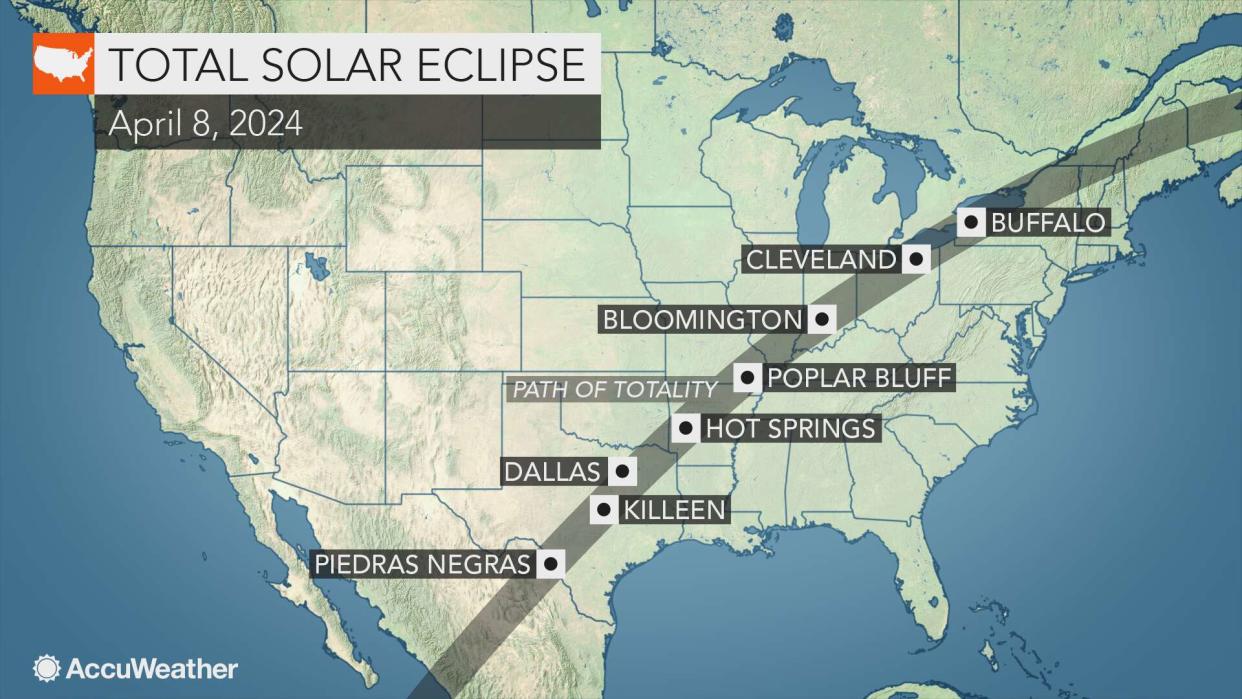Sky Shorts: Time to plan for viewing 2024 total solar eclipse

We are now just one year away from one of the grandest and awe-inspiring events that we can witness on Earth, a total solar eclipse!
On Monday, April 8, 2024, a large portion of Ohio will experience this once-in-a-lifetime event. A solar eclipse begins with a perfect lineup of the Sun, Moon and Earth.
A solar eclipse happens at New Moon. This lineup occurs only a few times a year due to the 5% tilt of the Moon’s orbit to Earth’s orbit around the Sun.
In order to see a solar eclipse, you must be in the dark part of the Moon’s shadow or umbra. If you are in the penumbra or light part of the shadow, you will see a partial eclipse.
For the 2024 eclipse, the umbra shadow trail is 124 miles wide. It is called the path of totality. You must be in the path of totality to see the total solar eclipse. On April 8, 2024, the shadow trail starts in Mexico, then into parts of the United States and Canada.
Much of Ohio will be in the path of totality. Unfortunately, the Dover area is just outside the path of totality. So, now is the time to start coming up with your plan to view this once in a lifetime event!
Another important note is that straight down the middle of the path is central line. Any location on central line will see the longest duration of totality. For this eclipse it will be nearly four minutes. The further you are away from central line, the less time you will experience totality.
Viewing safely will be the biggest concern. You must wear solar filter glasses to view the Sun. Never look at the Sun directly! The only time you can safely look at the Sun is during totality. When purchasing solar filter glasses, look for the international standard requirement code of ISO 12312-2. The American Astronomical Society has published a list of reputable solar glass vendors. The list of vendors can be found here: eclipse.aas.org/resources/solar-filters.
Another safety issue will be the large influx of people who will want to see this phenomenal event. Traffic will be immense. Again, start making plans.
Of course, we will need good weather and clear skies for the event. For us in northeast Ohio, we will either have bright blue skies or a blizzard!
Fortunately for us, we will have a dress rehearsal event on Saturday, Oct. 14, a partial annular eclipse.
We will not be in the shadow trail and will witness around 35% coverage of the Sun by the Moon. It will be a great way to practice safe viewing and learning other techniques for safe viewing. However, for those people in the path, they will not see the Moon cover the Sun entirely.
Why is an annular eclipse different? The Moon’s orbit around Earth is slightly elliptical. So sometimes it is a little further from the Earth and other times it is closer. During the October eclipse, the Moon will be at its furthest point from Earth. Therefore, the Moon will not cover the Sun completely. Those in the path will see the “Ring of Fire,” which is also a sight to see.
Mark your calendars for these two amazing astronomical events: Oct. 14, 2023, and April 8, 2024. As we approach these two dates, visit www.mckinleymuseum.org for more information and resources.

Night Sky for April
Planets and the Moon – Dazzling Venus dominates the evening sky all month, at magnitude -4. From April 9-12, Venus passes to the left of the beautiful open star cluster, the Pleiades. On April 22, the crescent Moon will be between Venus and the Pleiades. On April 23, the crescent Moon will be north of Venus, creating a stunning site. Mercury makes its best appearance of the year, during April. Mercury can be found to the lower right of Venus for the first half of the month. It reaches its greatest eastern elongation, 19 degrees from the Sun, on April 11. Mercury quickly fades in brightness during the third week of April. The crescent Moon joins Mercury on April 21, but you may need binoculars to spot Mercury. Mercury will be down and to the right of the Moon. Mars is high in the evening sky moving eastward through Gemini, the Twins. Mars continues to fade in brightness as it moves away from Earth. Mars starts the month 136.1 million miles from Earth and ends the month at 161.6 million miles away. Mars pairs with the waxing crescent Moon on April 25. Uranus is located between Venus and Mercury, low in the west, but is a challenge to spot. Saturn is low in the southeast before dawn. It rises 1 hour and 24 minutes on April 1 and rises 2 hours and 28 minutes on April 30, before the Sun. Saturn meets up with the crescent Moon on April 16. Jupiter and Neptune are not viewable in April.
Conditions are ideal for the peak of the Lyrid Meteor Shower on April 22, under a moonless sky.
We celebrate International Astronomy Day on April 29.
Constellations:
West – Look for the three stars in a line, which make up the belt of Orion. The bright red-orange star up and to the left of the belt is Betelgeuse. The bright blue-white star down and to the right of the belt is Rigel. Draw a line to the right, from the belt, to a red, orange star, Aldebaran, which is the eye of Taurus, the Bull. Aldebaran is part of the V shape of stars, which is the face of Taurus. To the right of Taurus, you will find the small cluster of stars, the Pleiades or Seven Sisters. Making a counterclockwise loop from the Pleiades, the next bright star is Capella. Continuing up, the two stars you see are Gemini, the Twins.
North – The Big Dipper is high in the sky. Following the two stars at the end of the cup to the next bright star, Polaris, or the North Star. The constellation Cassiopeia is down and to the left of Polaris and resembles a sideways letter "M”.
Overhead to East – Head back to the cup of the Big Dipper. Locate the flat part of the cup. Look high overhead for the shape of a backwards question mark. This is the head of Leo, the Lion. Now, arc off the handle of the Big Dipper to the bright yellow, orange star Arcturus. Look right for the bright blue, white star, Spica.
Binocular highlights – Facing west, you will see the small cluster of stars, the Pleiades or the Seven Sisters. The Pleiades is a beautiful open star cluster. Head to Orion, the Hunter. Scan below the three stars of Orion’s belt. You will see fuzzy area with bright stars. This is the Orion Nebula, a hydrogen gas cloud where new stars are forming. For a challenge, scan between Leo and Gemini. There you will find the Beehive Star Cluster.
For further night sky details, maps and audio, visit my website www.starrytrails.com.
Visit the Hoover Price Planetarium – Visit www.mckinleymuseum.org, for show dates and times! Planetarium shows are free with Museum admission. The Planetarium is located inside the McKinley Presidential Library & Museum, 800 McKinley Monument Drive, N.W., in Canton, Ohio. For more information, please call the Museum at 330-455-7043.


This article originally appeared on The Times-Reporter: Sky Shorts: Time to plan for viewing 2024 total solar eclipse

